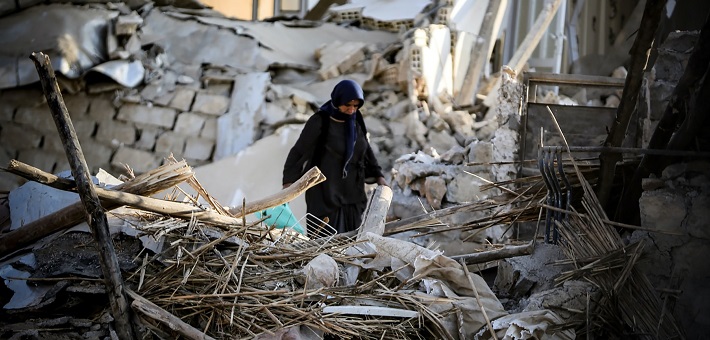Commentary on Mark 13:1-8
Mark 13:1-8 reveals a back and forth between Jesus and his disciples. In these exchanges, Jesus responds to the disciples by taking the conversation in a different direction. When one of the disciples marvels at the stones adorning the Temple, Jesus indicates that the stones will all be cast down (13:1-2). When the disciples ask Jesus when this event will happen and what sign there will be, Jesus cautions them against being led astray (13:4-8).
Mark 13:3-37, sometimes called the “Little Apocalypse,” describes wars, earthquakes, famines, and nations rising against each other. According to Adela Yarbro Collins, “Motifs of war, earthquakes, and famines in verses 7-8 are very general apocalyptic commonplaces.”1 While it is hard to determine if Mark 13 anticipates the Jewish-Roman War (66-70 CE) or responds to it, these warnings on Jesus’ lips anticipate challenges faced by the Jewish community in Palestine with the war and destruction of the Temple. It is easy to imagine these events felt like a telos, an end, for those who watched them unfold.
The events Jesus describes are merely the “beginning of the birth pangs” (13:8). With the lack of clarity on these events’ timeline, it makes sense that Jesus would warn the disciples not to be led astray by those who would claim to come in his name, claiming “I am.” It is tempting to cling to anything that promises a foothold at times when we feel everything is out of control.
While our context is radically different from first-century Palestine, our realities have been rapidly changing, from increasing wealth disparity, climate change reaching the “red zone,” and the rise of COVID-19 cases when many expected them to be falling. It is increasingly challenging to find a foothold in how to respond, what to do, and what will save us, as Simon Dein indicates: “Pandemics indicate the fragility of life and the world, chaos, engender paralyzing anxiety that the world is dissolving, a sense of detachment and raise significant issues of meaning resulting in existential crises.”2 These crises inspire big questions of who and how we are in the world; they likewise inspire big questions of in whom we believe and the shape that belief takes in practice.
The Text
As the disciple marvels at the stones in the Temple, the similar endings of words in Greek draw the auditor’s attention to the disciple’s words and Jesus’ response:
Disciple: Potapoi lithoi kai potapai oikodomai (notice the -i sound at the end of the words)
Jesus: Tautas tas megalas oikodmoas (notice the -as sound at the end of the words).
The words paint a picture of the disciples looking up at the Temple, inviting us to marvel with them at its beauty and then the shock of Jesus’ words that follow the words above: “You see these large buildings? Not one stone will be upon another that will not be cast down.”
Peter, James, and John asked Jesus privately about when to expect these things to happen and what to expect would happen. Their question reminds the reader that they do not understand what Jesus means by this statement. Even the disciples do not have privileged information regarding these events. Rather than describing when, Jesus tells the disciples to look out for those claiming to come in his name, echoing Jesus’ caution in Mark 12:38-44. Jesus does not communicate the character of these messianic claimants, but their claim to the title “I am” suggests they have designs on power that belongs to God alone. The disciples do not seem to have a privileged position here; they, like the “many,” are at risk of being led astray.
After Jesus cautions the disciples, he tells them of the things that are to come but does not provide a timeline. Instead, Jesus tells them these wars, earthquakes, famines, and struggles are not the culmination of the things to come. This line of thought continues until verse 37. The coming of the Son of Man is the culmination of this line of thought; in the midst of uncertainty, threat, and disaster, the messianic figure comes and gathers the elect. The telos, which could mean the end, goal, outcome, or culmination, is the Messiah.
Preaching Remarks
This text brings many challenges with it, especially to polarized societies. It can be a fearsome time to be a preacher, especially when words can take on political, social, or other valances that are unintended. In particular, issues that are not—at their face—partisan, have become a vehicle for partisan politics, whether one considers COVID-19 practices, global climate change, or how countries interact with other conflicted areas in the world. Many of us (preachers included) feel as if we are working twice as hard for half of the result. It can feel like it is all crashing down.
Maybe the stories of life right now are our own “Little Apocalypse” or, at the very least, a sort of end to the “before times.” This precise point is where we all need to hear the Gospel, that God is always about the business of making new futures possible. Walter Brueggemann asserts that preachers “traffic in a ‘fiction’ that makes true.”3 The good news of Jesus’ presence seems a fiction in the midst of crisis and disaster, and this place is precisely where preachers can imagine a different way forward for humanity. Whenever we hear reports of disaster, Mark 13 reminds us to not be led astray by messianic claimants that cannot save us; rather, we look for Jesus.
Notes
- Adela Yarbro Collins, Mark, Hermeneia (Minneapolis: Fortress Press, 2007), 12.
- Simon Dein, “COVID-19 and the Apocalypse: Religious and Secular Perspectives,” Journal of Religious Health 60 (2021): 6.
- Walter Brueggemann, Cadences of Home: Preaching among Exiles (Louisville: Westminster John Knox Press, 1997), 30.


November 14, 2021